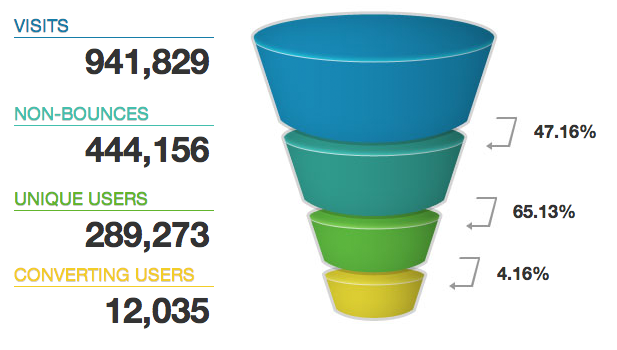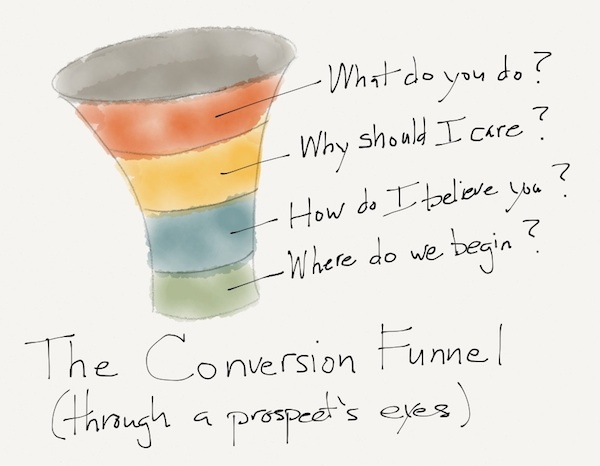The Conversion Funnel
A Snapshot of a Microtest's Viability
At this point in our microtesting process, we may have a relatively well-formed group of initial keywords leading to a few PPC ads testing our various propositions, which then lead to one or more landing pages. These landing pages, in turn hold the core of the proposition, clearly and impactfully stated, and pair with an appropriate Call to Action (CTA).
Depending on what we are testing, the stage of our offering (prerelease, prototype, waiting list, etc.), and our intent, the CTA could be anything from a simple email form to send more information, to an address to send a physical sample, or to sell the early offering itself. Our goal here is to capture information and potentially sales, as simply knowing the number of visitors passing freely into and out of our site provides us with nothing meaningful by which to make decisions or improve the offering.
The conversion funnel is a visualization or way of stating the steps in which our audience is engaging with the offering. More importantly, the conversion funnel makes weaknesses in the offering or presentation more readily evident so we can go about fixing them. In a conversion funnel as shown below, our goal in testing the offer is to understand where there may be constrictions in the conversion funnel causing us to lose an undue number of visitors/prospects.
Ultimately, the conversion funnel will become an early model of the offering's viability, and will begin to determine exactly how attractive the space is. It will give us a view of where the needs for improvement are... or if we are ready to "scale up" and increase the number of impressions/ad spend.
Whether talking to CEOs or VCs, a detailed conversion funnel can provide a meaningful picture of initial viability.We can structure our conversion funnel model with whatever criteria we choose to capture the goals of our microtest. The below example from Yahoo Commerce is on the simple side, but gives you an idea of what a basic funnel could look like.

The architecture I find helpful for creating conversion funnels is to consider all of the steps someone takes to reach your offering, the information and actions they take, and what goals you have for information capture and conversion. It is likely each step can be tracked through Google Analytics, AdWords, and form/sales data to provide a valid picture of the funnel.
Furthermore, if you draw your ideal conversion funnel and the steps it would capture on the whiteboard and find that you can only put numbers to 40% of the funnel, that is a sign that you need to capture that data in Analytics or find another way to understand that data realtime.
A Prospect-Centric View of the Funnel
Like all good research, understanding the conversion funnel is many times about perspective.
Where we may see statistics on how many prospects move from one area of the conversion funnel to another, we may easily lose sight of the human side of the equation, instead thinking of the funnel as some sort of faceless oracle. For this reason, it is essential to our understanding of the funnel to be able to look at it through a prospect's eyes, as well as their technology.
One example:
You notice that although your PPC ads are doing well, you are losing a significant proportion of customers at the "top of the funnel." In this case, some of your highest-quality keywords are resulting in a huge proportion of sub-minute duration ("bounce") visits to your landing page. Everything looks good on your Mac Pro with dual 30" monitors and fiber connection. What could possibly be wrong?
As much as we need to have an understanding of our prospects, we must understand the technology they are using and how adept they are at using it. Even with the otherwise most engaged prospect, slow page load times and mobile unfriendly design can cause us to lose a significant proportion of worthwhile prospects right off the top.
What you might want to consider as you get further into microtesting (or just as good practice, period), is to set up a second computer in the corner of your office specifically for viewing your sites through the "least common denominator" technology. Google Analytics will show you what browser and platform people are viewing your landing page on, but consider buying a 6+ year old, small monitor PC, loading an obsolete version of Internet Explorer, and slowing your connection speed using one of a few inexpensive programs. This will quite literally allow you to see your microtest assets through a user's eyes, and you may find that it is painfully slow to load, images may be missing, or that nice sample form crashes every time you use it.
Regardless of how you gain a more complete perspective, consider at each step in the funnel what value, proposition, and stimulus you are providing to a prospect. Scott Brinker provides an simple perspective of the conversion funnel's meaning for customers:

